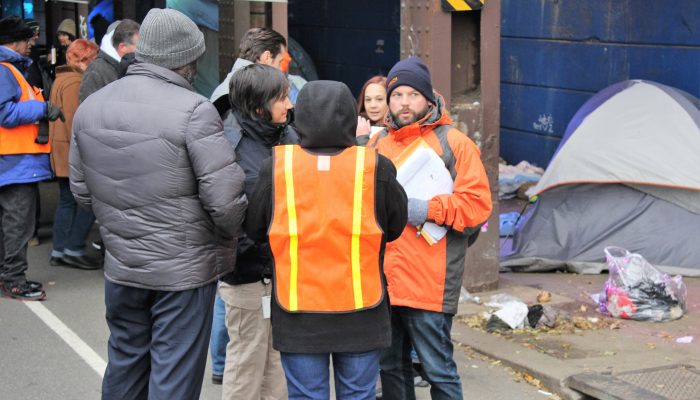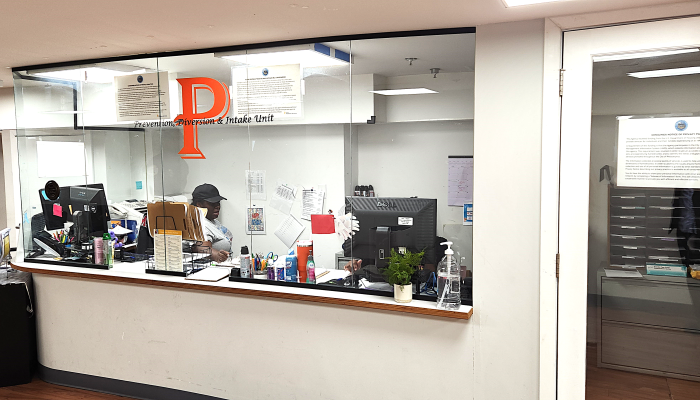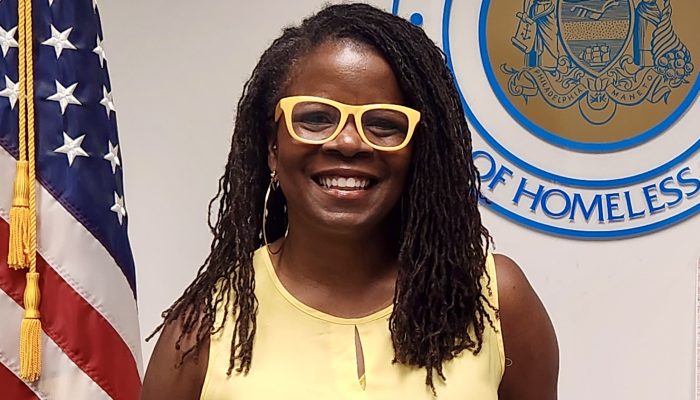Researchers from the University of Pennsylvania worked with us to create an independent report analyzing the City’s encampment resolution pilot program.
This program entailed compassionately, effectively, and permanently closing four large encampments in Philadelphia’s Kensington neighborhood.
Some strategies included establishing a deadline for closure, conducting constant outreach to encampment residents, providing services and treatment on site, and working with surrounding neighborhood residents to improve quality-of-life.
These encampments represented the intersection of several issues, most notably homelessness, America’s ongoing opioid crisis, poverty, and behavioral health challenges. Unlike other encampments across the United States, the Kensington encampments were in a dense residential neighborhood yards away from families, workers, and other residents.
In the Penn report, researchers looked at the first two encampment closures that took place in spring 2018. Later, the City would also close two other large encampments, the last on January 31, 2019.
Looking at the first two encampment closures and outcomes from May through October 2018, researchers discovered several things.
Those living in the encampments were from Philadelphia.
84 percent of all residents researchers surveyed were Philadelphians (page 7).
65 percent were originally from Philadelphia. Another 19 percent had already lived in Philadelphia for at least a year prior.
The encampments were diverse.
Researchers note that the population of the encampments was mixed racially and ethnically (page 21).
The population was 57 percent white, 31 percent Black, and 12 percent Latino.
Those living in the encampments wanted to be known and helped.
When outreach started to make contact with encampment residents to establish a “by-name list” identifying and counting each resident by their name, they readily gave them their names, birth dates, and other confidential information. They wanted to be known and helped.
Researchers note that having a the by-name list was decisive in the project’s success in part because it helped with data collection efforts (page 43).
The encampments were connected to the opioid crisis but also to other issues including homelessness and behavioral health.
93 percent of encampment residents reported active drug use. 79 percent were using opioids. 25 percent were also using alcohol; 43 percent were using cocaine (page 22).
It wasn’t just about drug use, though. 65 percent of encampment residents expressed other mental health challenges. Researchers believe at least a third have severe challenges, like schizophrenia, bipolar disorder, or major depression.
71 percent of all people surveyed expressed an interest in receiving help for mental health challenges.
And, 57 percent of those surveyed said they previously spent time in a homeless shelter. The median time spent was between six and nine months; 40 percent reported they were homeless for over a year, meeting the federal definition of chronically homeless (page 47).
Closing the encampments did not increase Philadelphia’s homeless population.
Researchers note that closing the encampments did not result in an uptick in the area homeless population but that an unrelated surge in summer of 2018 overshadowed the “tactical gain” made by closing the first two encampments (page 75).
They also noted that each time outreach succeeded in routing an encampment resident to shelter or other services, another new person would take their place (page 7). This indicated the need to permanently close the encampments.
Providing services and low-barrier housing is key.
While Philadelphia adapted some strategies first developed in San Francisco, it dramatically expanded coordination to provide services that improved outcomes. Services included:
- Bringing treatment on site.
- Helping encampment residents obtain ID so they could more readily access services later.
- Providing first aid and wound care to all residents especially intravenous drug users.
- Providing transportation to shelter and other service sites.
Because of the unified response Philadelphia took, about half of people from the encampments are now still in treatment or housing.
Researchers report that 56 percent of encampment residents were open to going to a shelter. This number jumped to 91 percent when they were asked if they would go to what’s known as a “low barrier” shelter: one where there are basic rules that do not include requirements of round-the-clock abstinence from drugs.
“Coupling the availability of services with closing encampments is the defining feature of the approach taken by [Philadelphia],” researchers note (page 23).
Philadelphia is ahead of the curve nationally in closing encampments.
Researchers repeatedly note that the unified response of multiple City agencies was key to the program’s success, calling it “an unusual degree of coordination and cooperation among an array of services” (page 76).
They also note that the encampments remained closed, making the pilot a success, (page 74).
There is still work to be done.
Despite the successes of the encampment resolution pilot, researchers noted that there were some areas to work on.
While the pilot was “the most detailed follow-up of any initiative seeking to engage people with services as part of an encampment closure,” the City still needs to work at coordinating data-gathering efforts across various departments (page 56).
There was also frustration by encampment survey respondents about not having adequate access to the shelter they personally preferred.
Likewise, researchers repeatedly noted that current resources for more permanent housing programs are insufficient, particularly for extremely vulnerable populations, like those living with severe mental health challenges, substance use disorder, and with extremely low or nonexistent incomes.




